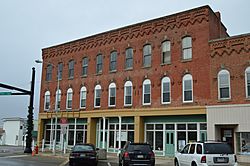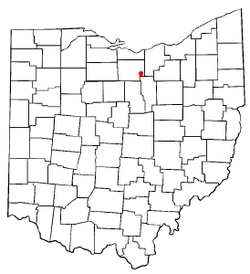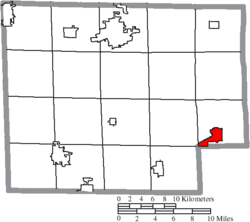New London, Ohio facts for kids
Quick facts for kids
New London, Ohio
|
|
|---|---|
|
Village
|
|

Former Gregory House Hotel downtown
|
|

Location of New London, Ohio
|
|

Location of New London in Huron County
|
|
| Country | United States |
| State | Ohio |
| County | Huron |
| Area | |
| • Total | 2.54 sq mi (6.57 km2) |
| • Land | 2.21 sq mi (5.71 km2) |
| • Water | 0.33 sq mi (0.86 km2) |
| Elevation | 984 ft (300 m) |
| Population
(2020)
|
|
| • Total | 2,416 |
| • Density | 1,095.69/sq mi (423.02/km2) |
| Time zone | UTC-5 (Eastern (EST)) |
| • Summer (DST) | UTC-4 (EDT) |
| ZIP code |
44851
|
| Area code(s) | 419 |
| FIPS code | 39-54908 |
| GNIS feature ID | 2399472 |
New London is a small village located in Huron County, Ohio, United States. In 2020, about 2,416 people lived there. It is a place with an interesting history and a mix of cultures.
Contents
History of New London
The first people to settle permanently in New London arrived in 1816. They named the village after New London, Connecticut. This was the home state for many of the early settlers. New London officially became a village in 1853.
In the early 1900s, New London was sometimes called "Ferretville." This was because it became a major center for raising ferrets in America. Around 20,000 ferrets were raised in the area each year!
Geography and Location
New London covers a total area of about 2.54 square miles (6.57 square kilometers). Most of this area is land, with a small part being water. The village is surrounded by New London Township to the north, west, and east. To the south, it borders Ruggles Township in Ashland County. New London is located about 24 miles south of Lake Erie.
Cultural Influences
New London's economy relies a lot on farming and making things in factories. Even though it's in the Great Lakes region and part of the Rust Belt, it has strong influences from New England and the Southern United States.
Early settlers came from Connecticut and other parts of the Northeast. They settled here in the early 1800s in an area known as the Firelands. You can still see their New England heritage in the village's buildings and the names of old families. New London also has a "village green," which is a common feature in many towns in Northern Ohio.
Later, in the mid-1900s, many new residents came from the Appalachian South. Most of these people were from Eastern Kentucky. They moved to New London to work in local farms and factories, and in nearby Cleveland. Today, you can see the influence of these Southern families in the friendly and welcoming nature of New London's residents. This mix of cultures has helped create a strong community.
Population Information
| Historical population | |||
|---|---|---|---|
| Census | Pop. | %± | |
| 1870 | 678 | — | |
| 1880 | 1,011 | 49.1% | |
| 1890 | 1,096 | 8.4% | |
| 1900 | 1,180 | 7.7% | |
| 1910 | 1,557 | 31.9% | |
| 1920 | 1,470 | −5.6% | |
| 1930 | 1,527 | 3.9% | |
| 1940 | 1,656 | 8.4% | |
| 1950 | 2,023 | 22.2% | |
| 1960 | 2,392 | 18.2% | |
| 1970 | 2,336 | −2.3% | |
| 1980 | 2,449 | 4.8% | |
| 1990 | 2,642 | 7.9% | |
| 2000 | 2,696 | 2.0% | |
| 2010 | 2,461 | −8.7% | |
| 2020 | 2,416 | −1.8% | |
| U.S. Decennial Census | |||
New London's Population in 2010
According to the census from 2010, 2,461 people lived in New London. There were 960 households, which are groups of people living together. About 649 of these were families.
Most of the people in the village were White (95.8%). There were also African American (1.8%), Asian (0.1%), and Pacific Islander (0.1%) residents. About 2.0% of the population identified with two or more races. A small number, 1.1%, were of Hispanic or Latino background.
About 35.8% of households had children under 18 living with them. The average household had about 2.51 people. The average age of people in the village was 37.4 years old.
Famous People from New London
- Philip Johnson, a well-known architect
- Robin Meade, a television personality
- Joseph Simon Newman, an entrepreneur, inventor, and poet
- Glenora Richards, a painter
See also
 In Spanish: New London (Ohio) para niños
In Spanish: New London (Ohio) para niños

